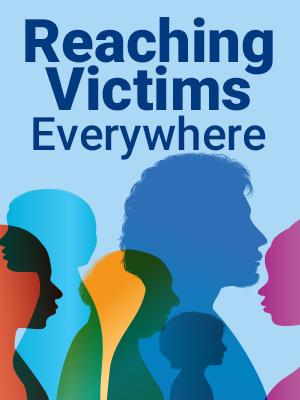Archival Notice
This is an archive page that is no longer being updated. It may contain outdated information and links may no longer function as originally intended.
Research and Evaluation
Data on Crime Victimization
In FYs 2019 and 2020, OVC funded two partner agencies—the National Institute of Justice (NIJ) and the Bureau of Justice Statistics (BJS)—in their endeavors to generate, collect, and analyze quantitative and qualitative data on victimization, victim services, and related topics critical to the field.
OVC continued an interagency agreement with NIJ to support research for the field, including efforts to better understand the financial costs of victimization, the experiences of at-risk groups, restorative justice programs, a study on the national victimization of tribal youth, and the overlap between victims and those who commit crime.
In FYs 2019 and 2020, OVC transferred nearly $3.5 million to NIJ to assess various projects that support victims of human trafficking:
- In FY 2019, the University of North Carolina at Chapel Hill received funding to partner with Safe Horizon, one of the Nation’s largest victim service providers, to conduct an evaluability assessment and formative evaluation of Safe Horizon’s Anti-Trafficking Program, which provides comprehensive case management, including social work and legal services, to sex and labor trafficking victims. The goal of the project is to develop evidence and products to guide services for, and responses towards, strengthening anti-trafficking initiatives across the United States.
- In FY 2020, Northeastern University received nearly $1 million to enhance understanding of the short- and long-term physical and psychological health consequences of sex trafficking on minor victims, and the factors that facilitate and impede health care access. Seven community-based organizations that provide services to minor sex trafficking victims from across the country will partner to capture the experiences of a large sample of minor sex trafficking survivors in the United States. As part of the study, youth participants will complete anonymous surveys and interviews with adult survivors of minor sex trafficking who can provide information and context about the physical and psychological health consequences of sex trafficking victimization and the barriers for facilitators of health care services and access.
- Also in FY 2020, the Regents of the University of Minnesota received funding to build on a previously funded National Science Foundation study on how sex trafficking operations recruit and retain potential victims—specifically networks and the flow of people, goods, and money—and the cascading impact of interventions on trafficking operations, victims, the marketplace, and society. The project has the potential to contribute to the field’s ability to inform practitioners of where interventions can be used to interrupt recruitment strategies and reduce the likelihood of victim replacement, and to ultimately reduce the number of victims of trafficking overall.
During the reporting period, OVC transferred more than $9 million to NIJ to support evaluation of service programs for crime victims:
- In FY 2019, the Children’s Hospital of Philadelphia received funding to conduct a formative evaluation of the hospital’s Violence Intervention Program, which provides services to youth and their families following community-based, interpersonal violent victimizations. While several hospital-based violence intervention programs exist nationally, most focus on the recovery needs of older adolescents and adults. This project will address the urgent need for victim services for youth younger than 18 years of age who have experienced community-based violence by defining the resources and activities required to effectively support the physical and psychosocial recovery of victimized youth and their families.
- In FY 2019, the University of Nebraska received funding to conduct a formative evaluation and evaluability assessment of Project Harmony, a large child advocacy center (CAC) in Omaha, Nebraska, that serves child victims of alleged child abuse. Despite the proliferation of CACs over the past 30 years, there is little research on the efficacy of the centers—specifically, which components are most effective at improving the coordination of child abuse investigations, reducing distress to children, and increasing offender prosecutions. This project will examine five core services within Project Harmony—forensic interviewing, advocacy, medical care, mental health services, and multidisciplinary teams—in an effort to lay the foundation for future CAC outcome evaluation efforts.
- In FY 2020, the Research Triangle Institute (RTI) received funding to conduct a formative evaluation of victim services programs funding through OVC’s Law Enforcement-Based Victim Services Program (LEV). Through a partnership with the International Association of Chiefs of Police, RTI will use grant funds to develop an inventory and typology of all LEVs; develop logic models and identify core components of a subset of sites; conduct evaluability assessments of 10 sites; develop recommendations for future outcome evaluations; and develop an implementation guide and fidelity measures.
- In FY 2020, nearly $303,000 was awarded to the RAND Corporation under the Research and Evaluation of Victims of Crime Program to conduct an evaluability assessment of the Harry and Jeanette Weinberg Center for Elder Justice, an elder abuse prevention and intervention program that provides shelter for older adults who have experienced abuse in the community. The goal of the project is to understand the paths that victims may take after experiencing elder mistreatment—whether going to a shelter, a hospital, or another type of facility—to determine whether there are individuals eligible to use the shelter who choose not to, and to identify comparable sites that could potentially shelter victims.
In FY 2020, RTI International received funding from NIJ, with support from OVC and OVW, to measure the impact of victim services. In recent decades, OVC has spearheaded efforts to build, grow, and professionalize the victim services field. As a result, our Nation’s service infrastructure for people impacted by crime has advanced immensely. Grantee and subgrantee data collected by OVC demonstrates how hard programs are working, in terms of the number of victims being served and the range of services offered. To continue to advance the field, victim service providers must move from measuring outputs to outcomes, and from anecdote to evidence in demonstrating the impact of these programs on victims’ lives.
The goal of the Measuring the Impact of Victim Services projects is to drive the victim services field from a focus on effort to a focus on results and effectiveness through the creation of an outcome measurement tool. The project team, composed of RTI International, the Justice Research and Statistics Association, and the Georgia Statistical Analysis Center, has three primary objectives to accomplish that goal:
- Through research, focus groups, and rigorous cognitive testing, build on existing efforts of victim service providers to develop a validated, trauma-informed, low-burden outcome measurement instrument that can be completed by survivors to measure service outcomes and perceptions of the quality of services provided.
- Develop a standardized methodology for survey administration and data analysis to provide victim service providers with detailed guidance on when, how, and to whom the survey should be administered.
- Customize an intuitive, freely available software application for victim service providers to use for administering the outcome survey, securely collecting the data, viewing the results through an interactive dashboard, and exporting data in an easily accessible format.
RTI and team are implementing this project with a focus on broad collaboration and engagement. This approach ensures that the tool, platform, and resulting data are workable across a range of settings and service providers and that the data can ultimately be used to demonstrate the impact of victim services and inform and improve the way services are provided.
Victim Services Statistical Research Program
OVC continued its support and partnership in advancing BJS’s Victim Services Statistical Research Program (VSSRP), which aims to build a critical body of knowledge for the field by collecting and analyzing data from victims and the diverse entities that serve them nationwide. In addition to enhancing information collected from existing sources of BJS data, the VSSRP includes a number of groundbreaking initiatives to collect information from victim service providers throughout the United States. This includes the first-ever National Census of Victim Service Providers (NCVSP) and the National Survey of Victim Service Providers (NSVSP)—both designed to help define and enhance understanding of all types of providers playing a key role in the response to crime victims, including those that are community- and justice system-based, as well as campuses, hospitals, corrections facilities, legal services, and more. The census data provides quantitative information about how many providers exist, their organizational structures, the types of services they offer, the crime types served, and staffing considerations.
Through a partnership between BJS and OVC, the study team conducted extensive outreach to increase awareness and encourage support and participation. This included targeted outreach in collaboration with known and trusted practitioner leaders and provider networks within the broader victim service provider field. Members of the study team also participated in a webinar and a podcast focused on bridging the gap between research and practice in victim services, discussing the goals of the NSVSP and how the results could be used to impact the victim assistance and adjacent fields, such as stakeholders throughout criminal justice and public health.
BJS Releases Report on First National Census of Victim Service Providers
Victim Service Providers in the United States, 2017, released in FY 2019, provides statistics from the NCVSP and describes the types of organizations that served victims, their locations, and the rate of victim service providers per 100,000 U.S. residents, by state. The survey found that nearly 90 percent of victim service providers were nonprofit or faith-based organizations (45 percent) or governmental agencies with staff or programs to serve crime victims (43 percent); hospital, medical, and emergency facilities with dedicated victim programs made up 3 percent of VSPs; and about 2 percent of VSPs were located in tribal organizations.
Service Provider-Specific Data Collection
Other research and development efforts focused on particular types of service providers, such as a collaboration between BJS and the Centers for Disease Control and Prevention’s National Center for Health Statistics to develop a new National Survey of Hospital Victim Services to better understand the range of hospital-based and affiliated services available for crime victims in health settings. The agency has also added, or is in the process of examining or adding, questions about victim services to existing BJS surveys, including, for example, surveys of law enforcement, corrections, prosecutors, and medical examiners’ and coroners’ offices. Collectively, these efforts will offer the most comprehensive national picture of victim service provision to date.
National Crime Victimization Survey
In FYs 2019 and 2020, OVC continued to provide funding to support the strengthening of victimization data through the redesign and modernization of the National Crime Victimization Survey (NCVS). This multi-year initiative to fill long-standing gaps in information includes efforts to—
- provide subnational estimates. While the original purpose of the NCVS was to provide estimates of victimization at the national level, the NCVS subnational program will generate victimization estimates at the state and local levels for the 22 largest states.
- modernize the survey instrument design and methodology.
- generate better and more comprehensive measures of crime.
- expand the information collected regarding formal and informal help-seeking behaviors, victim services, issues related to fear of crime, perceptions of neighborhood disorder and satisfaction with police, and the consequences of victimization.
Bridging the Gap Fellowship
In FYs 2019 and 2020, in partnership with BJS, OVC also continued its efforts to bridge the gap between research, policy, and practice through sustained support of its first-ever fellowship dedicated to improving the translation and dissemination of research and data for the victim assistance field, launched in FY 2015. In addition to providing direct support on the development of the VSSRP, and advisement on data-informed policy to OVC, BJS, and other components of the Office of Justice Programs, the fellow conducts outreach and engages with all corners of the field. The fellowship is designed to ensure not only meaningful translation and dissemination of existing information to improve victim response and services, but also that the voices and needs of practitioners and victims of all types of crime are heard and considered as a source of collaboration and expertise throughout these efforts.




